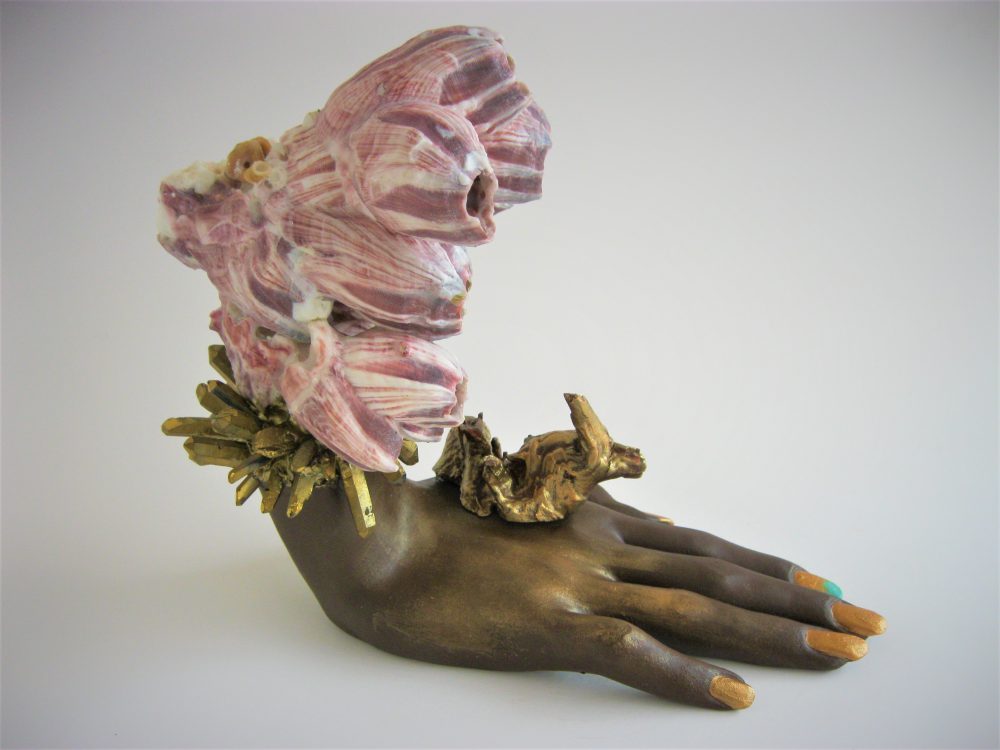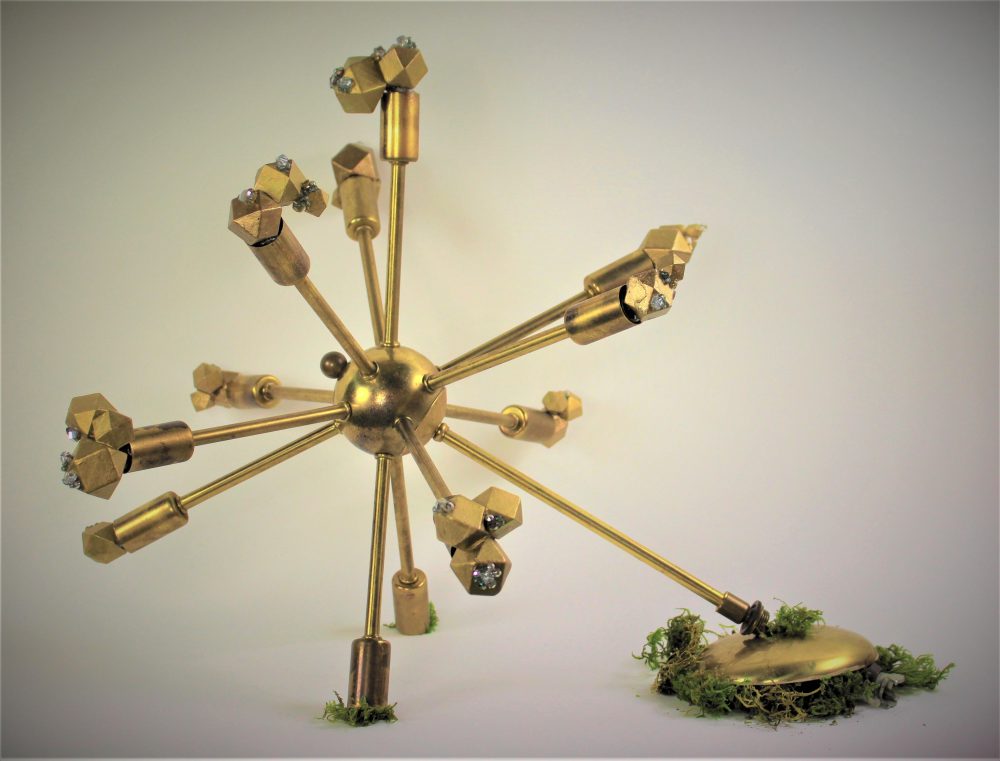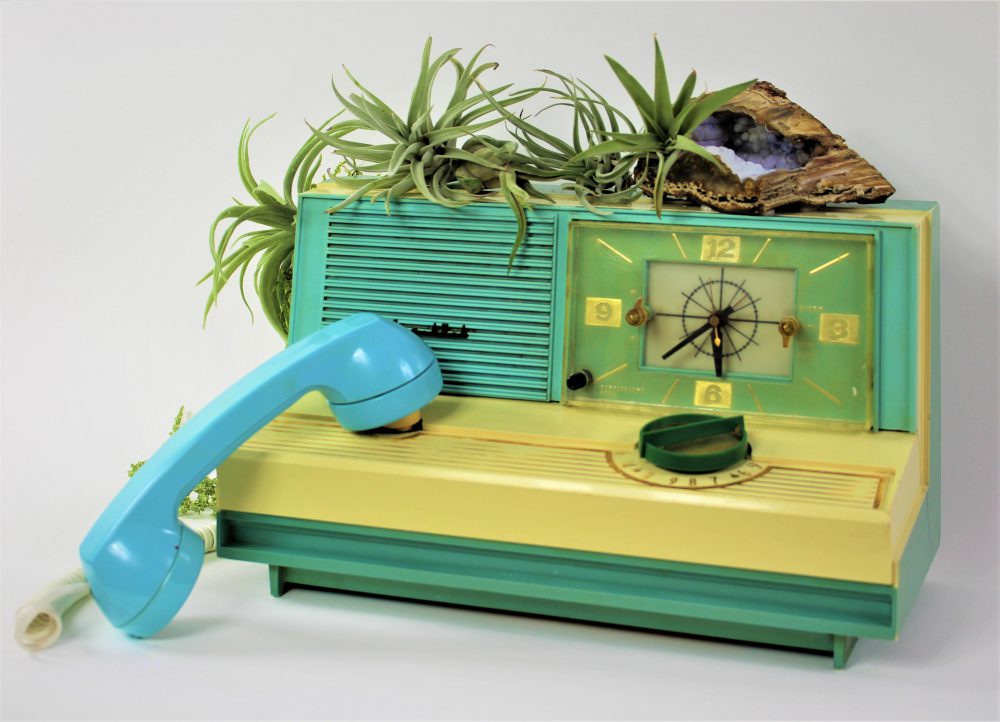For Advanced Souls: Rhonda Wheatley at the Hyde Park Art Center
Matt Morris visits Rhonda Wheatley’s recent exhibition at Hyde Park Art Center in Chicago, which includes objects created to promote healing, transcendence, and time-space travel.

Rhonda Wheatley, Power and Energy Amplifier, 2015. Vintage mannequin hand, barnacle cluster, titanium quartz points, cholla cactus wood, and acrylic paint. Courtesy the artist.
I was vomiting for days leading up to last fall’s elections. Nothing particularly new was being revealed. Trump was a mirror, reflecting back long-shadowed historical conditions—our nation’s violent hatred of any race or immigrant or disabled body that could be rendered in contrast to its self-appointed norms, its deep hostility towards women, and its profoundly shortsighted self-interest that privileges an alienated and egotistically fragile individuality over civic good. As Republican victories for the presidency and in Congress set in, I was distinctly concerned about what we would do with these blatant reminders—most of all, how we would treat each other.
Rhonda Wheatley’s spring exhibition at Chicago’s Hyde Park Art Center—“A Modern Day Shaman’s Hybrid Devices, Power Objects, and Cure Books”—expresses unassuming and rare powers within this contemporary milieu. In her show, ingredients for holistic medicine and spell casting (incantations, secret herbs, crystals, a goat horn) are made to fill, decorate, and support more-banal-seeming found objects. Old telephones, radios, and cameras occur frequently within the composite sculptures, signaling the more psychic transmissions that the accompanying wall texts and instructions for the devices describe. The objects and writings on view could be situated into pedigrees of assemblage and language-based Conceptual Art, but those lineages would limit a gregarious metaphysics that loosens art to do much more than intellectually and creatively provoke: To take Wheatley at her word, the exhibition can open up inter-dimensional telepathic travel, activate clairvoyance, re-wire consciousness, and devour negative energy. (For full disclosure, Wheatley and I collaborated on a performance last year involving a perfume I’d made and a text she’d written.)
The text that accompanies Inner Space Travel Device, 2017, describes the object as a vintage light fixture embellished with wooden and glass beads, imbued with the power to allow users to perceive “one’s self and surroundings in numerous places or dimensions simultaneously” and to “step into the continuous hum of the ‘eternal now,’ outside time.” The added caveat, “For advanced souls only, at device’s discretion,” marks out a curious interplay amongst a viewer’s perceptions, projections, and beliefs of what “advanced” might mean here.

Rhonda Wheatley, Inner Space Travel Device, 2017. Vintage light fixture, wooden beads, and glass beads. Courtesy the artist.
Elsewhere a painted mannequin hand with attached clusters of fluorite crystal tetrahedrons is accompanied with the text: “Empath Protector. Helps empaths create healthy energetic boundaries so that they may clearly distinguish their own emotions, needs, and desires from those of others.” These composite forms are enabled through language to address both incredibly abstract and exceedingly practical aspects of lived experience.
My background being raised in extremist religious contexts that couldn’t peacefully hold my queerness, feminism, and curiosity predisposes me to skepticism toward rhetorical structures that depend on an acceptance of underlying, unverified principles in order to engage with their contents. Similar resistances may have contributed to art history’s repression, requalification, or at least sidelining of mysticism as art shifted from religious to more secular contexts (think of the still relatively unknown pioneer of abstraction Hilma af Klint, Sun Ra’s outsider-insider cult status, or the degree to which Joseph Beuys’ version of shamanism is conceptualized more than felt or practiced).
So perhaps it’s desperation commensurate with a darkening age when underlying traumas reassert themselves as federal policy that has me casting about for alternatives in art’s potential. What distinguishes Wheatley’s power objects from dogma is the artist’s experimental methodology—not so much engineering ideological outcomes as seeing what she can do with what she has. Her approach parallels the “(Soma)tic Poetry Exercises” by writer CAConrad, who says their method “investigates that seemingly infinite space between body and spirit by using nearly any possible THING around or of the body to channel the body out and/or in toward spirit with deliberate and sustained concentration.”

Rhonda Wheatley, Conscious Dying Device, 2017. Vintage clock radio, vintage telephone receiver, fossilized coral, living air plants, artificial plants, and moss. Courtesy the artist.
The visual wit of Wheatley’s rejoinders adds pleasure and playfulness to the decision-making each viewer faces. Her arrangement of cameras, a vacuum tube, and crystals is told to permit users to “attend ‘mystery schools’ on other planes,” and that sounds like what we pretty much need right now. To what extent words, objects, and the metaphysics that may hover beyond the exhibition are believable as interventions into other realms of consciousness is left up for each person to decide.
Across one pedestal are arranged vials of potions and wet-looking potpourri with the instruction “Activate by gazing into jars and bottles. Gazing must be 100% voluntary.” Each one is attributed with a different power. I chose to gaze into Elixir for Un-Learning Race-, Gender-, and Sexuality-Based Hatred: “Targets the roots of one’s learned prejudicial hatred and hostility.” While conceits of alternative realities and metaphysics often smack of a denial to stay with the troubles of this place, Wheatley demonstrates how clearly her vision accounts for our society’s ills and seeks to implement multiple, magical modes of addressing their underlying, more soulish causes.
Editor's Note
Rhonda Wheatley’s “A Modern Day Shaman’s Hybrid Devices, Power Objects, and Cure Books” was on view February 12–May 7, 2017, at Hyde Park Art Center (5020 S. Cornell Avenue) in Chicago.



